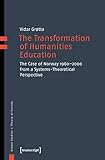The Transformation of Humanities Education : The Case of Norway 1960-2000 from a Systems-Theoretical Perspective / Vidar Grøtta.
Material type: TextSeries: Global Studies & Theory of Society ; 3Publisher: Bielefeld : transcript Verlag, [2019]Copyright date: 2019Description: 1 online resource (572 p.)Content type:
TextSeries: Global Studies & Theory of Society ; 3Publisher: Bielefeld : transcript Verlag, [2019]Copyright date: 2019Description: 1 online resource (572 p.)Content type: - 9783839443071
- Education -- Research
- Education
- Humanities -- Study and teaching (Higher) -- Norway -- History -- 20th century
- Humanities -- Norway -- History -- 20th century
- Niklas Luhmann
- Sociology
- Education
- Educational Research
- Higher Education
- Niklas Luhmann
- Norway
- Science
- Sociology of Education
- Sociology of Science
- Sociology
- Systems Theory
- University
- SOCIAL SCIENCE / Sociology / General
- Education
- Educational Research
- Higher Education
- Niklas Luhmann
- Norway
- Science
- Sociology of Education
- Sociology of Science
- Sociology
- Systems Theory
- University
- 001.30710481 23/eng/20230216
- AZ183.N67 G768 2019
- online - DeGruyter
| Item type | Current library | Call number | URL | Status | Notes | Barcode | |
|---|---|---|---|---|---|---|---|
 eBook
eBook
|
Biblioteca "Angelicum" Pont. Univ. S.Tommaso d'Aquino Nuvola online | online - DeGruyter (Browse shelf(Opens below)) | Online access | Not for loan (Accesso limitato) | Accesso per gli utenti autorizzati / Access for authorized users | (dgr)9783839443071 |
Frontmatter -- Contents -- Preface -- Part one: Theory -- 1. Introduction to part one -- 2. Niklas Luhmann’s systems theory -- 3. Key concepts in systems theory -- 4. Comparing theories for higher education research -- 5. The use of theory in this study -- Part two: Admissions -- 6. Introduction to part two -- 7. The humanities and higher education policymaking, 1955–1975 -- 8. Stagnation in humanities education, 1975–1987 -- 9. The second expansionist period, 1987–2000 -- 10. Conclusions to part two -- Part three: Curricula -- 11. Introduction to part three -- 12. History -- 13. English studies -- 14. General literature studies -- 15. Philosophy -- 16. Conclusions to part three -- Part four: Careers -- 17. Introduction to part four -- 18. The period 1960–1975: Humanities education as teacher education -- 19. The period 1975–1985: The transformation -- 20. The period 1985–2000: Humanities education and “boundaryless” careers -- 21. Conclusions to part four -- Part five: Conclusions -- 22. Conclusions to the study -- Afterword, 2000–2018 -- Appendices -- References
restricted access online access with authorization star
http://purl.org/coar/access_right/c_16ec
This first comprehensive study of Norwegian humanities education employs systems theory to analyze its transformation from a form of teacher training to its modern status as research-oriented generalist education.Using historical documents and statistical analyses, Vidar Grøtta shows that the expansion of the post-war research system in Norway led to an increase in admissions to humanities education in the 1960s and an ensuing research drift in humanities curricula. Interacting with certain political dynamics and the knowledge economy that has emerged since the 1970s, this research drift resulted in a shift in humanists' career patterns and a transformation of the societal functions of the humanities.The most recent developments in Norwegian humanities education, from 2000 to 2018, are outlined and discussed in the afterword to this volume.
funded by Department of Education at the University of Oslo
Mode of access: Internet via World Wide Web.
In English.
Description based on online resource; title from PDF title page (publisher's Web site, viewed 26. Aug 2024)


